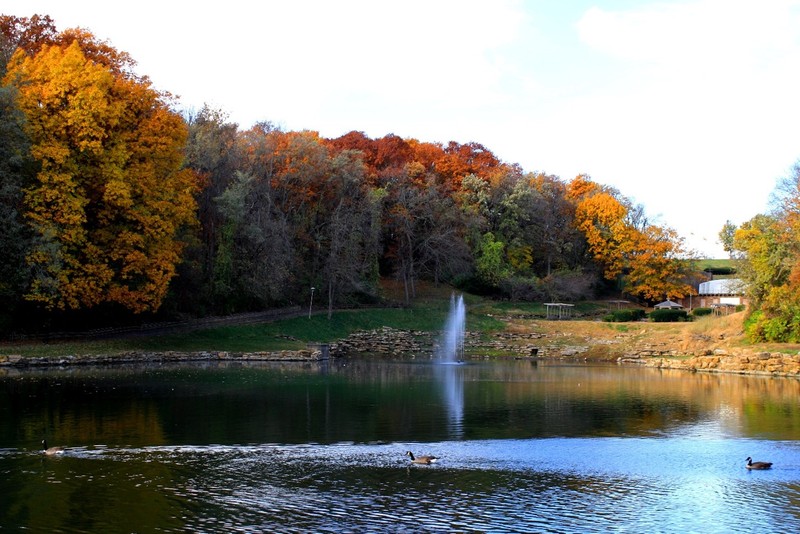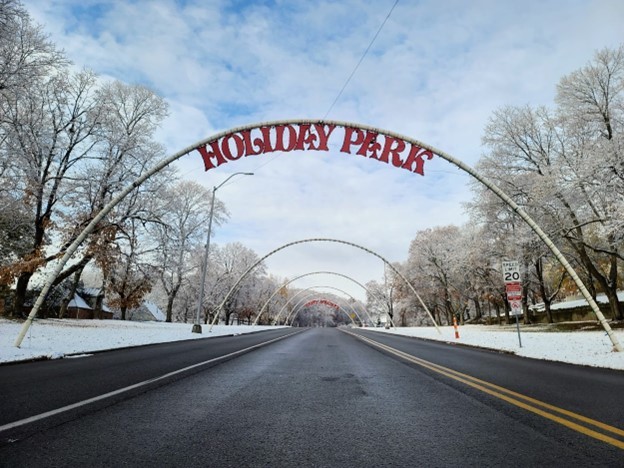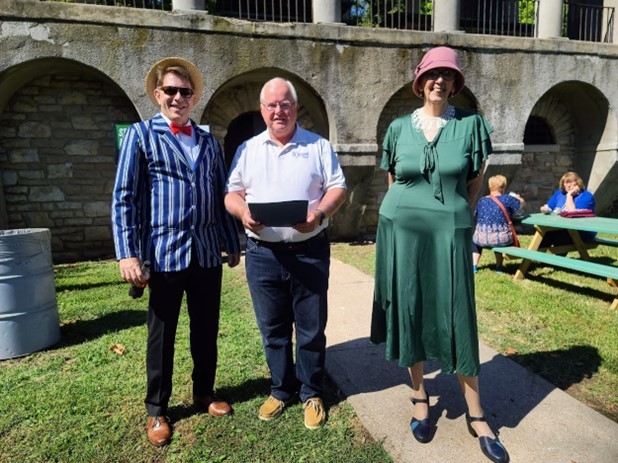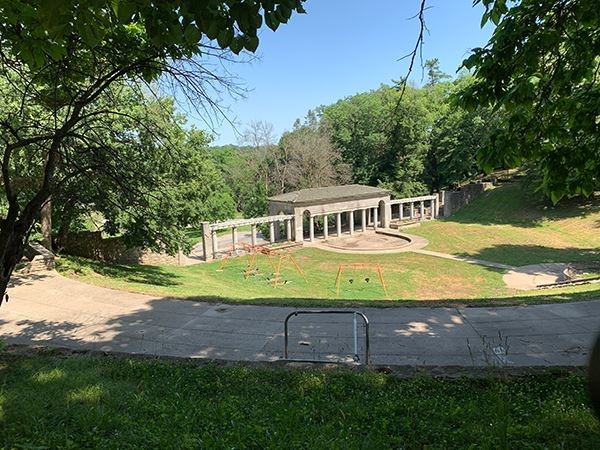Krug Park
Introduction
Text-to-speech Audio
Spanning an impressive 162 acres, Krug Park is one of the oldest and most developed parks in St. Joseph. Among the amenities offered by the park are picnic areas and shelters, an amphitheater, an Italianate-style “castle”, playgrounds, scenic walking trails, and a lagoon that is regularly stocked for fishing. This charming park also boasts a history of holiday cheer. Between Thanksgiving and January 1, Krug is transformed into “Holiday Park,” filled with wonderful lights and decorations to drive through. An ambitious improvement program is underway for the park, funded by Parks Tax funds. What is already a wonderful place to spend a day is going to be truly spectacular!
Images
The lagoon at Krug Park

Holiday Park is a beloved tradition

Krug Park is a popular venue for events and gatherings of all sorts

You never know who you'll meet at the park!

The Children's Circus area is getting a major facelift and will emerge as a performance venue

Backstory and Context
Text-to-speech Audio
Krug Park is one of the oldest public parks and largest in St. Joseph, starting as a 20-acre gift of land to the city in 1888 by businessman Henry Krug Sr. and his brother William. The Krugs stipulated no intoxicating beverages were to be sold on the grounds, nor any gambling permitted. After another 20-acre donation, the park opened to the public on September 1, 1888. On the day of the park’s opening, St. Joseph citizens could pay a 10-cent round-trip fee to take the electric street cars to and from the new park. The Krug family made additional gifts of land, ultimately increasing the size of the park to its current 162-acres.
The park gained popularity quickly as a place for sightseeing and attending free concerts. During the winter months, ice skating in the park became a popular activity, people of all ages went to the park to skate with friends and family. After Krug’s first winter, landscaping and building efforts began. This early phase of the park’s development was largely the brainchild of the Superintendent of the Parks Department from 1887-1917, Rudolph Rau. Under Rau an ambitious landscaping program was undertaken, a large greenhouse built, and
and a charming bandstand erected. Krug Park became the place to go on a summer’s evening to enjoy the flowers and enjoy live music, including an opera sponsored by the St. Joseph Traction and Lighting Company in June 1895!
By 1890, the park had achieved popularity for outdoor activities, giving the citizens of St. Joseph a place to stroll and to enjoy an escape from the growing city. That year, the Park Board proposed the addition of a menagerie to Krug Park’s attractions. The plan was to initially introduce an elephant, with the restriction that it was not permitted on the grass. The menagerie opened in 1896 and remained a popular attraction for many years.
Prior to the First World War, Krug Park was the site of two murders. In September 1895, Lafe Holland, a paper hanger, was stabbed when he was attacked by a group of five men. Thomas F. Harris killed his sweetheart, Madeline Rowbotham at the entrance to the park in July 1913. Harris, a 29-year-old streetcar conductor was angry that Madeline had refused to marry him and was seeing another man. He ambushed her and slit her throat with a razor. Despite these tragic events, the park’s popularity remained strong, and development of its many amenities continued.
The 1920s were a period of real changes in the appearance of Krug Park. The Parks Board with the assistance of George Burnap began planning the installation of several of its largest features, the Refectory and Children’s Circus, the Krug Park Bowl, and the lagoon.
In 1922, the Children’s Circus was completed. This was an elaborate play area featuring two 42-foot slides. That same year work began on the Renaissance-style structure known as the Refectory; it was intended to be a grand concession stand.
Kug Park’s amphitheater, the Krug Park Bowl, was completed in 1926 after five years of planning and construction. Designed by noted landscape architect George Burnap, the Bowl takes advantage of the natural landscape in the park. Krug Park Bowl is immense, with room for 40,000. Two years after its construction, the Bowl hosted a grand undertaking: the Passion Play. Scheduled for August 13, 1928, and the following eight days, this immense project required significant support from the St. Joseph community. This was to be the first American presentation of the Passion Play. With more than 150 sponsors and a cast of 1200, the anticipated audience numbers were projected to be the largest in St. Joseph’s history. The city requisitioned a large number of sheep and purchased two camels, horses, a camel, a monkey, and a donkey to add to the spectacle. The play was entirely in German, with a 60-person cast from Germany, and supporting players from St. Joseph and Kansas City. Over the course of the nine-day showing, an estimated 100,000 attendees went to watch this grand display. Despite the high attendance and the entry fees ranging from fifty cents to two dollars, the play’s expenses vastly exceeded the amount earned. This was not to say that the play was anything short of a phenomenon, however, as its memory still lives on.
One of the most beloved features of Krug Park, the lagoon, was constructed in 1928 and was ready for ice skating in January 1929. The 3-acre pond quickly became a favorite place to watch waterfowl and paths around its shores still attract walkers.
The attractions at Krug Park changed over the years, and the park became less formal. The menagerie closed, many of the elaborate plantings disappeared, and the greenhouse was demolished. They were replaced by playgrounds, picnic tables, and more extensive walking trails. Krug Park is fondly known as St. Joseph’s Crown Jewel and is one of the most popular parks in the city.
Cite This Entry
Schutte, Kim. "Krug Park." Clio: Your Guide to History. February 28, 2024. Accessed April 17, 2025. https://theclio.com/entry/178056
Sources
“Opening of Krug Park”, St. Joseph Gazette, Sept. 01, 1888.
“The Rambler”, St. Joseph Gazette, July 23, 1888.
“Krug Park”, St. Joseph Gazette, Sept. 02, 1888.
“Skating at Krug Park”, St. Joseph Gazette, Jan 20, 1889.
“Krug’s Park”, St. Joseph Herald, Mar. 13, 1889.
The Catholic Tribune, Feb. 15, 1890.
“A Zoological Garden”, St, Joseph Herald, July 26, 1890.
“Summer Opera,” St. Joseph Herald, May 9, 1895.
“Concert at Krug Park,” St. Joseph News Press, July 25, 1895.
“Stabbed in a Fight”, St. Joseph News-Press, Sept. 9, 1895.
“Gave Him a Death Wound,” St. Joseph Daily Gazette, Sept. 13, 1895.
“Was Jealous So He Killed Sweetheart”, St. Joseph News Press, July 14, 1913.
“Harris Murder Trial is to be in January,” St. Joseph News Press, Dec. 8, 1913.
“Krug Park will be Entirely Changed,” St. Joseph Gazette, Jan. 9, 1919.
“Krug Park Refectory,” St. Joseph News Press, June 28, 1922.
“Slides for Children,” St. Joseph News Press, July 6, 1922.
“Great Bowl in Krug Park is about Ready,” St. Joseph News Press, May 29, 1926.
“Bowl Work Started,” St. Joseph Gazette, July 31, 1928.
“Krugs Give Land as City Park Addition,” St. Joseph Gazette, Dec. 23, 1928.
“Winter Sports Nearer,” St. Joseph News Press, Dec. 31, 1928.
Weeks, Clyde. Krug Park: St. Joseph’s Crown Jewel. Blacksnake Creek Press, 1993.
Margaret Slayton, “St. Joseph Now Offers 2 Trout Fishing Location Opportunities,” St. Joseph News Press, Jan. 28, 2018.

